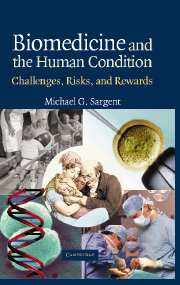Book contents
- Frontmatter
- Contents
- Preface
- 1 Challenges, Risks, and Rewards: Learning to Control Our Biological Fate
- 2 Learning to Breed Successfully
- 3 How Life is Handed On
- 4 Cells in Sickness and Health
- 5 Experiences in Utero Affect Later Life
- 6 Infection, Nutrition, and Poisons: Avoiding an Unhealthy Life
- 7 Signs of Ageing: When Renovation Slows
- 8 Cancer and the Body Plan: A Darwinian Struggle
- 9 Fighting Infection
- 10 Are Devastating Epidemics Still Possible?
- 11 Discovering Medicines: Infinite Variety through Chemistry
- 12 Protein Medicines from Gene Technology
- 13 Refurbishing the Body
- 14 Living with the Genetic Legacy
- 15 Epilogue: Signposts to “Wonderland”
- References
- Index
12 - Protein Medicines from Gene Technology
Published online by Cambridge University Press: 06 August 2009
- Frontmatter
- Contents
- Preface
- 1 Challenges, Risks, and Rewards: Learning to Control Our Biological Fate
- 2 Learning to Breed Successfully
- 3 How Life is Handed On
- 4 Cells in Sickness and Health
- 5 Experiences in Utero Affect Later Life
- 6 Infection, Nutrition, and Poisons: Avoiding an Unhealthy Life
- 7 Signs of Ageing: When Renovation Slows
- 8 Cancer and the Body Plan: A Darwinian Struggle
- 9 Fighting Infection
- 10 Are Devastating Epidemics Still Possible?
- 11 Discovering Medicines: Infinite Variety through Chemistry
- 12 Protein Medicines from Gene Technology
- 13 Refurbishing the Body
- 14 Living with the Genetic Legacy
- 15 Epilogue: Signposts to “Wonderland”
- References
- Index
Summary
Diabetes was the first example of a human disease that could be attributed to a deficiency of a specific protein (insulin) and that could be corrected by an equivalent derived from animals. That startling success was the inspiration for replacement therapies for other diseases. With the advent of gene technology in the 1970s, a generic method for making human proteins on an industrial scale became available. This provoked a gold rush to start the process of making a host of potentially useful proteins on a commercial scale. The discovery came at a critical moment, when infectious agents had seriously compromised the safety of clinically used blood proteins and hormones of human origin. Using gene technology, blood clotting factor VIII and growth hormone were rendered conclusively free of viruses. Gene technology has now revealed many proteins that have potentially important roles to play in controlling pathological symptoms of hundreds of clinical disorders.
Genetically Engineered Insulin
Insulin has a special place in the annals of biotechnology. In the 1920s, insulin transformed the short and sickly lives of diabetics and was arguably one of the most significant achievements in any field in those dismal times. The astonishingly bold idea was that a human physiological function lost in diabetics – the capacity to regulate the level of glucose in blood – could be restored by an injected protein obtained from cattle. No concept of the nature of the protein existed in 1922, and it was 1953 before a precise chemical structure was revealed.
- Type
- Chapter
- Information
- Biomedicine and the Human ConditionChallenges, Risks, and Rewards, pp. 244 - 265Publisher: Cambridge University PressPrint publication year: 2005



